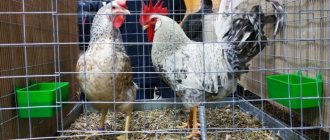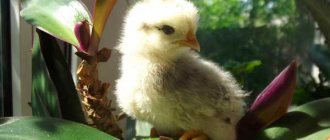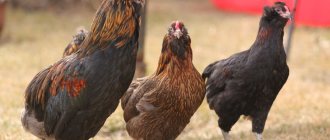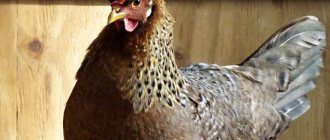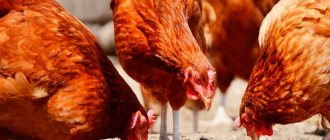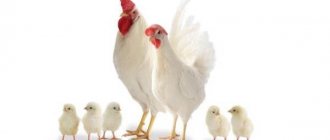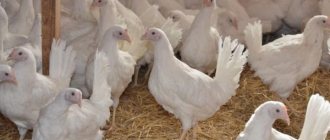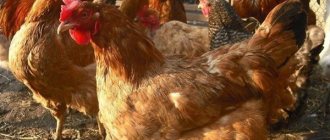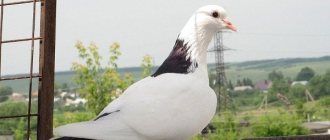Among meat and egg breeds, Yurlov chickens are of average popularity. It's all about character traits and consumption of large amounts of food, in comparison with representatives of other chicken varieties. However, the Yurlovsky vocalists also have fans who value them for their strong immunity and good productivity. But the main advantage of birds is their singing abilities. A full description of the breed can be found in the article.
Origin story
The vocal breed appeared in the Russian Empire in the middle of the 19th century as a result of crossing local egg chickens with representatives of heavy meat (Brahma, Cochin) and fighting breeds. It got its name from the name of the village of Yurlovo.
The Yurlovsky vocal breed of chickens was formed on the principle that mature roosters have a sonorous melodic voice. At the same time, late ripening—late sexual maturity—has developed, which has a positive effect on the male’s voice. For this purpose, young animals that showed an early tendency to sing were culled.
How to choose a cockerel with good vocal abilities?
In recent years, roosters of the Yurlovskaya Vociferous breed are rarely selected for vocal characteristics. In general, there was an unspoken division in the line - a more productive bird with good meat characteristics or a vocal one.
Those who are a true connoisseur of the crowing of Yurlov roosters need to learn how to choose suitable individuals. There are more chances to buy a real singer in the Oryol or Lipetsk region. These birds have been bred there for a long time. Representatives of this breed are also sold at the Poultry Institute and at exhibitions.
Attention! The best singers are males with an unsightly appearance, since during selection the main attention was paid to the vocal qualities of the bird.
Features of selection of young animals with singing characteristics:
- Males whose singing duration exceeds 8 seconds are allowed for breeding.
- A good sign and basis for selection is late ripening. Individuals who have bloomed after a year are given preference.
- Vocal offspring appear in chickens with a low-pitched cackle.
The Yurlov breed of chickens is still popular in Russia. Poultry farmers value it for its high meat productivity and large egg size. However, not everyone is a fan of the original Russian breed line. Many people find it difficult to care for and maintain; others are annoyed by the loud crowing of a rooster at dawn. It is impossible not to take into account the cocky nature of birds when choosing a breed for home breeding.
Appearance and breed standard
Yurlovsky vocal chickens are very beautiful, large and strong birds.
Exterior
They are characterized by the following exterior characteristics and description of the breed:
- Male individuals have a large head with a rounded nape, a wide frontal bone and pronounced brow ridges. The head of females is slightly smaller.
- The eyes are brown, orange or red, shiny. Black vocal birds have brown eyes, while those with a light color have yellow and red eyes.
- The head is smooth, without feathers, the skin is red.
- The beak is strong, but small, curved, black, dark bronze or yellow with a fold at the bottom.
- The comb can be rose-shaped, nut-shaped or leaf-shaped. Leaf-shaped - low, up to 4 cm in height with 7 teeth.
- Earrings and earlobes are medium size, oval, smooth, red.
- Males have a well-developed chest, a large scruff, and a raised body in the chest—the “Orlov posture.” Chickens have a long and raised body, but it is smaller than that of roosters.
- Vocal birds, regardless of gender, have a wide, well-developed back, a small but heavily feathered, compressed tail set perpendicular to the back, and a full, formed belly.
- The wings fit tightly to the body and have a medium span.
- Yurlovsky chickens have elongated strong legs, long metatarsus up to 18 cm high in roosters and up to 15 cm in hens. Fingers are straight. The metatarsus and toes are painted black, yellow or bronze. The claws are black or yellow, the soles are beige.
- The body of day-old chicks is covered with black down, the belly is yellow.
The exterior of the rooster and hen, photos and descriptions of appearance characterize the breed as aggressive, fighting, with a sharp frown.
Plumage
The body plumage is sparse and loose. Despite this, the chickens are very beautiful.
Various colors of Yurlov vocal chickens are possible:
- Birch . The feathers have a black and white pattern.
- Black . The plumage is matte black; the mane and back may be golden.
- Silvery white . The body is painted white, the tail, mane and bottom of the wings are black.
- Salmon . Vocal males have a matte black body and tail, dark red shoulders, a mane and coverts on the lower back that are light fawn with a red tint. Chickens of this color are beautiful. The plumage of their body and tail feathers are light fawn with a pink tint, and the mane, back and tail feathers are light brown.
Chicken breeding
Good hens can hatch up to 100% of the chicks. And the best of the best can devote the entire summer to hatching two offspring following each other. No more than 15 eggs from among the largest and cleanest are placed under the hen. Choughs hatch their offspring in a separate room, in a slightly darkened, dry place. The hens are fed dry food and watered with clean water. The moment of hatching must be caught in order to remove the empty shell and distribute the chicks to other hens, leaving 2-3 babies under the mother so that she is better accustomed to her new role.
The chicks are fed protein food. At the first feeding, a boiled grated egg is given. From the second day, minced meat, cottage cheese, and maggots are added. Young animals are kept in large boxes, which are always warm and light. This is a mandatory condition, since chickens take a long time to grow feathers and can freeze.
Note!
It is impossible to keep chicks under a red lamp all the time, otherwise it will cause curvature of the fingers.
For the first three months, the chicks are intensively fed with mixed feed, high in minerals and vitamins. They also give greens and vegetables. At one and a half months old, the chicks are released to the adult flock for a walk. At this age, they don’t have to fear for their lives - the chickens will accept them as family.
Productive characteristics of birds
The Yurlovsky vocal breed, by the nature of its productive qualities, belongs to the meat-egg group. The average weight of chickens is 3–4 kg, roosters reach a weight of 3.5 to 5.5 kg. The meat has high taste and broth characteristics, the meat yield is at least 65%. By 5 months, the average weight of vocal roosters is 3.2 kg, hens - 2.4 kg.
Egg production reaches 120–160 eggs in the first year of life. You can achieve higher rates - 170–175 eggs per year from one vocal laying hen. The average egg production rate of the flock is 85%.
The eggs are large in size. Their average weight ranges from 58 to 80 g. Laying hens are distinguished by their large egg size in the second year of life, after molting: there are specimens weighing 95 g. Due to the peculiarities of selection, birds of the vocal breed reach sexual maturity late. Eggs have a strong cream or brown shell.
Fertility and hatchability of eggs averages 80–85%. A hatchability rate of 90% can be achieved.
Puberty and egg production
One of the main disadvantages of the Oryol chicken lies in its late egg production. While most purebred chickens begin to lay eggs at the age of 4-6 months, songbirds begin to lay eggs only at 7-8 months, or even later. This is explained by the same notorious fighting genes - an individual by nature is designed in such a way that it first builds muscle mass and weight, and only then begins sexual development. This is why late hens do not always become good mothers.
However, the productivity of laying hens itself is quite acceptable, although Yurlov chickens are considered a meat breed. The eggs, although there are not very many of them, impress with their commercial qualities - they are very large (70-75 grams), with a strong shell and excellent taste. The average egg laying rate for one laying hen is 150-180 eggs per year, which is considered high for this type of chicken.
Hatching instinct
Not all female Yurlov chickens can boast of a good chick-brooding instinct. There may be “unlucky mothers” in the group, and you can get good offspring only by correctly selecting individuals for the tribe. After all, even a good laying hen may not produce offspring if the rooster is not suitable.
A properly composed family is already the key to a good litter. Preliminary selection of male roosters begins at the age of two months. Chickens - at the age of 3-4 months. The final choice is made by September, taking into account age, health and appearance. Pullets that begin laying at the age of 7 months will lay eggs and hatch eggs well in the future. Individuals that start laying eggs late are not always distinguished by their kindness towards their babies. A bird that will bear healthy and numerous offspring has good external characteristics. Breeding chicken must have distinctive breed characteristics. For incubation, calm hens are selected, tested over the previous year. The best hens will sit in the nest almost continuously.
The best father is the rooster with the longest duration of singing and a pleasant low timbre. The cockerel must be young (less than one year old), having started singing relatively recently. Considering that the rooster has fighting blood, he often does not behave too gallantly with the hen. After the honeymoon, many chickens have traces of the excessive ardor of the male. And some saki may even become ill or seriously injured. Therefore, the presence of a large rooster near a fragile female should be limited or a special vest should be placed on her back to protect her from abrasions, bites and torn feathers.
By the way!
Only 50% of the chicks will have similar plumage to the parents. The remaining half of the chicks can be painted any color.
Character
The Yurlov breed of chickens is selected for a singing duration of 6 seconds or more. The crowing of a loud rooster accompanies victory over an opponent and the liberation of territory from strangers.
The crowing of a rooster is a secondary sexual characteristic and is combined with the functions of the producer: the ability to care for chickens, call them to feed, and protect them from enemies. At the same time, males can be quite aggressive.
You should not keep Yurlovsky vocal breed chickens in large groups. This can even cause pecking in chickens.
Roosters begin to fight from an early age, so from 3 months it is better to keep them separately from females. Vocal chickens do not tolerate limited space and are in dire need of walking.
Productivity Description
In terms of ripening, the bird is late, because this is exactly what its creators sought. Thanks to such indicators, males develop a better voice and talent. Late maturation is also influenced by heavy weight. Chickens take a long time to develop muscle mass; they become mature at 8-9 months.
An amazing breed of chickens, the Yurlovsky Vociferous, is popular not only among professional poultry farmers, but also among amateurs.
Roosters grow to weigh up to 6-7 kg, chickens are usually 2 kg lighter. The breed cannot boast of high egg production, but laying hens lay large eggs weighing from 70 g. In a year, a chicken can lay up to 160 eggs.
There is an instinct for incubation, but it is peculiar. The laying hen sits on the eggs without any problems whenever she wants and gets up and leaves at any time. In theory, this behavior is not inherent in chickens that are not hybrids or purebred representatives. However, in reviews, bird owners describe such observations. The hen will have to be constantly monitored, and it is better to send the eggs directly to the incubator.
Features of keeping Yurlovsky vocal chickens
Birds of the Yurlov breed are distinguished by their endurance, resistance to diseases and unpretentiousness to living conditions. At the same time, the temperature regime of the poultry house is important for them. For good productivity, the temperature in the poultry house should not fall below 12°C. Daylight hours should last 13–14 hours.
There should be no drafts in the room, but fresh air circulation is necessary. The volume of the room per individual should be 0.5 m³.
The best flooring for a poultry house is a deep, permanent litter of peat, straw or sawdust. These substrates absorb moisture well. If necessary, add material. Take out the litter 2 times a year.
Poultry house equipment also matters. Chickens of the Yurlovsky breed need perches and nests with bedding made of straw and bran at a height of at least 1 m from the ground. Since the breed is characterized by active searching behavior, they must have sufficient walking.
Care
For each vocal hen, plan 10 cm of feeding and 2.5 cm of watering. It is necessary to select feeders that are protected from raking out and spilling of feed. The feeder is filled no more than a third. For mineral additives (shell rock, chalk, limestone, gravel), a separate feeder is installed.
Drinkers use vacuum, nipple, and groove drinkers. It is important to reduce splashing of water onto the litter and clogging of the drinking bowl with droppings and bedding material.
As a result of wet litter, diseases of vocal breed chickens such as coccidiosis, necrobacteriosis, pododermatitis, etc. occur.
If necessary, dry wet areas using quicklime.
The bird of the Yurlovsky vocal breed is highly resistant to diseases.
If they have free-range housing, proper feeding and the creation of optimal conditions in the poultry house, they are not afraid of diseases.
Feeding
An adult vocal bird must be limited in feeding. Excess feed will lead to obesity in the oviduct in laying hens and excessive weight gain in roosters, which is fraught with loss of productivity, injury and increased culling of hens. Birds of the vocal breed, which are raised for meat, are fed ad libitum with food with a high protein content until slaughter.
The basis of nutrition for laying hens should be grains and high-quality compound feed. In winter, a chicken should receive 100 g per head, and a loud rooster - 150 g of whole and chopped grain, 50 and 100 g, respectively, of succulent feed (pumpkin pulp, zucchini). Fishmeal, cottage cheese, and whey are used as protein components.
In the absence of walking, high-calorie foods such as boiled potatoes, sunflower or soybean cake and meal are limited. After the appearance of fresh grass and the organization of daily walking, the amount of grain in the diet is reduced.
Breeding
To maintain a vocal breed at home, it is necessary to take into account some selection features:
- When recruiting families to obtain high fertility, 1 productive rooster is needed for every 12–20 hens. The exact number of vocal laying hens depends on the age and activity of the male.
- For incubation, eggs are selected that were laid no later than 6 days ago, of medium size, weighing at least 52 g, of regular shape and with a dense, smooth shell without visible damage.
- Chickens of the Yurlovsky vocal breed have a pronounced brooding instinct and can hatch chicks naturally. Up to 17 eggs are placed under one hen. The nest with the hen should be placed in a warm, dark place, with a feeder and drinking bowl placed nearby.
- Artificial incubation of eggs is possible. The technology takes into account a gradual decrease in temperature in the incubation chamber, turning and moistening the eggs.
- To preserve the breed, it is necessary to update the herd.
- In order to increase the productivity of poultry, it is necessary to select for breeding laying hens with a live weight of at least 2 kg and with good egg production.
Features of care and feeding
High egg production is achieved through proper nutrition:
- After hatching and drying the fluff, the chickens are fed 6-8 times a day with boiled chopped eggs. On the 3rd day, they begin to mix cereal porridge and low-fat cottage cheese. From 2 to 6 months, active growth of the young occurs. In addition to food for weight gain, chickens are given vitamins. The younger generation is completely transferred to complex store-bought feed, and the frequency of feeding is reduced to 3 times a day. The diet includes vegetables, root vegetables, and herbs.
- Adult chickens are given whole grain cereals or ground grain mixtures. Males eat up to 150 g of food per day, and females - 100 g. In winter, chickens are fed wet mash with the addition of grass meal once a week. Vegetables and root crops are given at 100 g per head. Laying hens are fed protein-rich feed; maggots, fermented milk products, and fish can be given.
Chickens love warmth.
It is important to monitor the temperature; it ranges from 25 to 30 degrees. In summer, for young animals and adults, daytime feeding is replaced by grazing outside.
One of the main characteristics and features of the singing breed of chickens, Yurlovskaya Vociferous, is considered to be high feed consumption. Because of this deficiency, birds are not in demand by farmers engaged in industrial breeding.
Raising chickens
Two-week-old chickens
Raising chickens yourself is not difficult if you follow some rules.
In the first 3 days of cultivation, the temperature on the litter should be +26...+32°C. This regimen promotes timely resorption of the yolk sac. From the fifth day, the temperature is gradually reduced to 18°C.
It is important to provide vocal breed chickens with enough water to protect against dehydration and stimulate the digestive and excretory systems of the body. Food and water must be clean, fresh and freely available.
For normal stomach function, vocal chickens need roughage food - small feed, crushed grains of wheat or corn, ground oatmeal, millet, semolina. You can give cottage cheese, liquid kefir, chopped herbs.
Content principles
The Yurlov breed is not capricious when it comes to care. The only thing that is detrimental to it is growing it in cramped areas. Space is the main condition in keeping a vocal bird; cages are categorically unacceptable. For the floor, it is a good idea to use a peat moss bedding. It perfectly absorbs moisture, keeps chickens’ limbs dry, which protects their joints from diseases, and the body as a whole from infectious pathologies.
The chicken coop, in addition to its size, must withstand a stable temperature regime. Birds are not fans of extreme cold, so additional heating in cold weather is necessary. In the summer season, the room should be well ventilated, but not drafty. And have free access to the yard and back.
| Roosters begin to sort things out at a very young age. In order to prevent this, you need to separate them from the laying hens as early as possible (preferably at 3 months). In the future, the removed roosters can be kept in one enclosure without changing the composition of the group. |
A box intended for chicks must be heated to +25C and maintained in this mode constantly. The chickens are given the usual food for babies:
- semolina;
- boiled chopped egg;
- ground grain;
- compound feed
24-hour availability of clean drinking water is mandatory.
The Yurlov breed is too popular for breeding on an industrial scale, as it does not have the highest egg laying rates. But for small poultry farms or private farmsteads, it perfectly satisfies all the requirements for productive qualities. And if you breed chickens of the Yurlovsky variety exclusively for meat, then there is no price for them at all. Such an undertaking will bring constant success and benefit.
Advantages and disadvantages
The advantages of the Yurlovsky vocal breed are confirmed by numerous reviews. It is characterized by:
- High egg and meat productivity.
- Good taste of meat and eggs.
- Large eggs compared to egg breeds.
- High fertility, hatchability and survival rate of offspring.
- Disease resistance.
The disadvantages include:
- Some aggressiveness in males.
- Late productivity.
- Impossibility of growing in cages and in limited areas.
- Low meat productivity compared to meat breeds.
Molting and break in egg production
Molting begins in early autumn with a sharp reduction in daylight. The Yurlovskie feathers change within two to a maximum of three months. At this time, the chicken stops laying eggs, but some of them still remain weakly productive. The molting process can be accelerated by diversifying the chickens' diet and increasing daylight hours through artificial lighting. So the flock will finish molting in 1.5-2 months. To maintain the health of all birds during this period, they should be kept very clean and the diet should be diluted with healthy food. Variety consists of adding succulent herbs, increasing the proportion of protein feeds of animal origin, and adding vitamins and amino acids.
Photo gallery
Description of Moscow black chicken
Moscow Black is a meat and egg breed, suitable for both commercial and private breeding. It has a calm, balanced character and is capable of laying eggs even in the most extreme conditions for chickens.
Appearance
These purebred birds have distinctive external characteristics:
- chickens are pure black, some have a copper-colored head and neck;
- roosters have brighter colors: golden-copper plumage is present on the head, neck, back and shoulders;
- elongated body, strong muscles, developed wings and tail;
- the chest is wide and protrudes forward, the neck is of medium length, the head is large;
- the crest is small and erect, the beak is curved, the lobes are red;
- the iris of the eyes is orange.
Productivity
Productivity depends on the conditions of detention. With a lack of light and feed, the number of eggs decreases, and with excessive feeding, Moscow black chickens are prone to obesity, which also affects egg production.
Important! A gutted laying hen weighs about 2.5 kg, a rooster weighs 3.5 kg. These figures are on average only half a kilogram lower than those of broiler chickens. Laying hens of this variety begin to lay eggs at six months of age.
With proper feeding, one hen produces 210-250 eggs per year with an average weight of 60 g. The shell color varies: from beige to brown. In stressful situations, there is no decrease in egg production, as in other breeds
Laying hens of this variety begin to lay eggs at six months of age. With proper feeding, one hen produces 210-250 eggs per year with an average weight of 60 g. The shell color varies: from beige to brown. In stressful situations, there is no decrease in egg production, as in other breeds.
Moscow black chicken eggs
Yurlov chickens and loud roosters in the chicken coop
Both the chicken coop and the walking area are equipped with drinkers, feeders, and containers for mineral supplements (gravel, chalk, crushed shells). The feeding front is 10 cm, the width of the drinking bowl per hen is 2.5 cm. The degree of filling of the feeders is 1/3 of the height of the sides.
If a gravity drinker is used indoors? Can be made from an ordinary pipe by cutting it into two halves. Then you will need a drainage pit outside the room.
A reasonable solution would be to install containers with sand and ash in the enclosure. These are “baths” in which the bird gets rid of parasites and cleans its feathers.
Yurlov chickens and loud roosters by Igor Lunin
Hatching in an incubator
The frequency of turning the eggs in the incubator is three to four times daily. Temperature maintained in an artificial hen:
- 1-7 days – 40 degrees;
- 8-14 days – 39 degrees;
- 15-24 days – 38 degrees;
- when chicks hatch from eggs - 36 degrees.
Let's end it here! Yurlov chickens and vocal roosters are described in the material of another poultry farmer, see his advice at this link.
Subscribe to site updates and ours in Yandex Zen. We have a lot of interesting information ahead for poultry farmers.
See you later, colleagues!
See modern products for poultry and livestock farmers that improve the health of pets and make our work easier.
